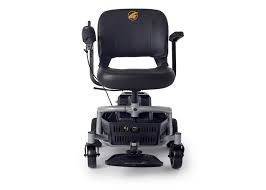For individuals with mobility impairments, maintaining independence and freedom to explore daily life is often a crucial aspect of well-being. Power wheelchairs have revolutionized mobility by offering motorized solutions that enable users to move with ease, comfort, and safety. As technology advances, these devices become increasingly sophisticated, versatile, and user-friendly, making them an essential tool for many around the world. Whether for everyday use or specialized needs, understanding the features, benefits, and options of power wheelchairs can help users and caregivers make informed decisions that enhance quality of life.
Understanding Power Wheelchairs
What Are Power Wheelchairs?
Power wheelchairs are motorized mobility devices designed to assist individuals with limited or no ability to walk. Unlike manual wheelchairs that require physical effort to propel, power wheelchairs operate via electric motors controlled by a user-friendly interface such as a joystick or alternative controls. These devices provide reliable, smooth transportation, allowing users to navigate various environments with minimal physical exertion.
Specifically created for individuals with disabilities or mobility challenges, power wheelchairs significantly enhance independence, safety, and access to social, recreational, and work opportunities. They are differentiated from manual wheelchairs by their powered movement capabilities, which cater to users with reduced strength, endurance, or posture stability.
Types of Power Wheelchairs
Standard Power Wheelchairs
These are the most common models, characterized by a basic design focused on indoor and outdoor usability. They typically feature a rigid frame, simple controls, and moderate battery ranges. Ideal for users seeking straightforward mobility solutions for everyday tasks.
Trapeze or Mid-Wheel Drive Wheelchairs
Mid-wheel drive models are celebrated for their exceptional maneuverability, especially in tight spaces. Their small turning radius makes them perfect for indoor environments such as homes, offices, or crowded public places, offering nimble navigation without the need for extended space.
Center-Wedged and Rear-Wheel Drive Wheelchairs
Center-wedged and rear-wheel drive models offer specific advantages in stability and outdoor handling. Rear-wheel drive wheelchairs are often preferred for traversing uneven terrains like gravel or grass, while center-wedged designs strike a balance between agility and stability.
Heavy-Duty Power Wheelchairs
Designed for users requiring higher weight capacities or looking to venture into rugged outdoor environments, heavy-duty models feature reinforced frames, larger motors, and robust tires. They are essential for larger individuals or those who frequent outdoor spaces.
Key Components of Power Wheelchairs
- Frame and chassis: Comprising a sturdy structure that supports the user and components.
- Motor(s): Responsible for propulsion, with some wheelchairs featuring multiple motors for enhanced control.
- Battery system: Provides power; options include gel, AGM, or lithium-ion batteries, each with differing lifespan and charging needs.
- Control interface: Joysticks, switches, or touchscreens that enable user input and commands.
- Wheels and tires: Designed for performance on various terrains—pneumatic or solid tires.
- Seating and support features: Adjustable seats, cushions, and support for comfort and posture.
Choosing the Perfect Power Wheelchair
Considerations and Factors
User’s Mobility Needs
Assess whether the user primarily needs to maneuver indoors, outdoors, or both. Consider terrain types, space constraints, and environmental factors. Additionally, evaluate the user’s physical condition—posture support, strength, and endurance—to select a model that offers proper support and ease of use.
Power and Battery Life
Range per charge is vital for planning daily activities. Check the battery specifications, such as battery type and charging time. A longer-lasting battery ensures less downtime and better independence.
Size and Portability
Determine if a foldable or rigid frame best suits transportation needs. Foldable models are easier to carry in vehicles, while rigid frames tend to be more durable and stable.
Control Options
Beyond the standard joystick, options include sip-and-puff systems, head controls, or customized controls tailored to specific disabilities, enhancing accessibility and ease of operation.
Additional Features
Adjustable seating, suspension systems for shock absorption, and accessories such as lighting, storage, or assistance devices contribute to a user-centered experience.
Assessing Fit and Comfort
Proper assessment by specialists ensures the selected power wheelchair aligns with the user’s needs. Trial periods and demo sessions are critical to gauge comfort, control responsiveness, and compatibility. Customization—from seat height to support features—maximizes safety and comfort.
The Benefits of Power Wheelchairs
Using power wheelchairs offers numerous advantages:
- Increased independence: Users can navigate freely without relying on caregivers.
- Enhanced mobility and freedom: Access to various environments, including outdoors and uneven terrains.
- Improved quality of life: Ability to participate in social, recreational, and occupational activities.
- Ease of use: Minimizes physical strain compared to manual wheelchairs.
- Safety and stability: Features like anti-tip mechanisms and sturdy frames enhance user confidence.
Challenges and Limitations
Cost Concerns and Insurance Coverage
High-quality power wheelchairs can be expensive, often ranging from $1,500 to over $30,000. Insurance plans, Medicaid, or Medicare may cover part or all of the cost, but approval processes vary. It’s essential to understand coverage options and potential financing plans.
Maintenance and Repairs
Regular maintenance, including battery checks, tire replacements, and mechanical tune-ups, ensures longevity and safety. Users should work with certified technicians for repairs to maintain warranty and performance.
Battery Life Limitations
While modern batteries are durable, they do require regular charging and eventual replacement. Planning for battery lifespan is vital for uninterrupted mobility.
Accessibility and Environmental Factors
Outdoor terrains, narrow doorways, and uneven surfaces may pose challenges depending on the wheelchair type. Selecting a model suited for the primary environment is crucial for optimal use.
Innovations and Future Trends in Power Wheelchairs
Lightweight Materials and Design
Emerging models utilize advanced materials like carbon fiber, making power wheelchairs lighter and more portable without sacrificing durability.
Smart Technology Integration
Next-generation devices incorporate IoT (Internet of Things) features, enabling remote diagnostics, navigation assistance, and customization via smartphone apps. These innovations improve convenience and user control.
Customization Through 3D Printing
3D printing allows for tailored support components and accessories, enhancing comfort and fit based on individual needs.
Autonomous and Semi-Autonomous Features
Future models may include semi-autonomous navigation, obstacle detection, and AI-driven adjustments, making power wheelchairs even safer and easier to operate.
Maintenance and Safety Tips for Power Wheelchair Users
Regular Maintenance Checklist
- Inspect tires and replace if worn
- Check battery charge and connection
- Test control interfaces for responsiveness
- Ensure mechanical components are secure
Battery Care and Charging
Charge batteries regularly, avoid deep discharges, and store in a cool, dry place. Follow manufacturer guidelines for optimal performance.
Safety Guidelines During Use
- Use seat belts and harnesses when available
- Navigate slowly in crowded or unfamiliar spaces
- Avoid climbing steep slopes or rough terrains unless suited for the model
Troubleshooting Common Issues
- Loss of power—check battery charge and connections
- Unresponsive controls—test control device and wiring
- Poor maneuverability—inspect tires and mechanical parts
Cost, Insurance, and Purchasing Guidelines
| Aspect | Details |
|---|---|
| Average Price Range | $1,500 – $30,000+ |
| Insurance Coverage | Medicare, Medicaid, private insurance may cover partial costs |
| Purchase Options | Consult healthcare professionals, visit specialized suppliers, try before buying |
| Customization | Model selection, seating, controls, accessories tailored to user needs |
How to Purchase a Power Wheelchair
- Consult healthcare professionals to assess needs and obtain prescriptions or recommendations.
- Visit specialized suppliers or authorized dealers who provide expert guidance and demonstration models.
- Try different models to evaluate comfort, control, and suitability before making a decision.
- Order customization based on body measurements and personal preferences, ensuring optimal fit and support.
- Complete insurance paperwork and understand warranty and service plans.
Future Outlook for Power Wheelchairs
The future of power wheelchairs looks promising, with ongoing innovations aiming to enhance user experience. Lighter designs, smarter technology, and autonomous features will make these devices increasingly intuitive and accessible. As research advances, we can expect more personalized, safe, and efficient mobility solutions for all users, further breaking down barriers and fostering independence.
Frequently Asked Questions (FAQs)
- What is the average lifespan of a power wheelchair?
- With proper maintenance, a typical power wheelchair can last between 3 to 5 years, though high-quality models may last longer.
- Can I use my power wheelchair outdoors?
- Yes, many power wheelchairs are designed for outdoor use, especially heavy-duty and all-terrain models.
- How do I ensure proper maintenance of my power wheelchair?
- Follow the manufacturer’s maintenance schedule, regularly check batteries and tires, and seek professional servicing as needed.
- Are power wheelchairs covered by insurance?
- Many insurance plans, including Medicare and Medicaid, offer coverage, but approval and reimbursement vary. Verify with your provider.
- How do I choose the right control options?
- Work with a rehabilitation specialist to select controls that match your physical abilities, such as joysticks, head controls, or sip-and-puff systems.
- Can power wheelchairs be customized?
- Absolutely. Features like seating, controls, and accessories can be tailored to fit individual needs for maximum comfort and functionality.
In conclusion, power wheelchairs are transformative mobility devices that significantly enhance independence, safety, and quality of life for individuals with mobility challenges. By understanding the different types, features, and considerations outlined in this guide, users and caregivers can make informed choices that best suit their lifestyle and needs. As technology continues to evolve, the future promises even more innovative, user-friendly, and accessible powered mobility solutions. Seek professional advice, explore your options thoroughly, and step confidently into a more independent future.
For more information, you can visit authoritative sources like WheelchairNet or Medical News Today.





